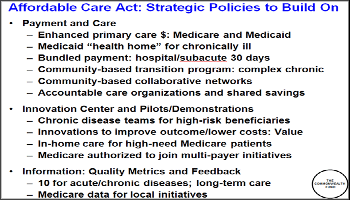The U.S. health care system is notoriously disorganized and difficult to navigate for even the most sophisticated patients. The problems are particularly pronounced for those with complex chronic conditions, who see multiple providers and take multiple prescription medications. All of this fragmentation leads to poor health outcomes and higher spending on the very population that needs coordinated care the most.
As of 2010, treating people with multiple chronic conditions, including the elderly and disabled populations, accounted for 30 percent of total U.S. health care spending. Beneficiaries eligible for both Medicare and Medicaid account for roughly half of this spending, totaling $304 billion. Even though these beneficiaries, known as dual eligibles, account for only 10 percent of Medicaid and Medicare beneficiaries, they consume 38 percent of total spending in these programs. To achieve savings and improve outcomes, The Affordable Care Act establishes new pilot and demonstration projects that will provide a foundation for changing the way we pay for and deliver care.
On Thursday, August 11, 2011, more than 250 congressional and administration staff, journalists, and other Washington, D.C., policy stakeholders convened for a briefing that highlighted the need for better coordinated care for the chronically ill population. Presenters offered examples of successful private and public sector interventions that are both improving health outcomes and mediating health care costs for chronically ill populations, and discussed provisions in the Affordable Care Act that could help encourage the adoption of effective care coordination models for this population.
Held jointly by The Commonwealth Fund and the Alliance for Health Reform, the briefing featured Randy Brown of Mathematica Policy Research, Inc., who addressed the relevant research on care coordination models and the Affordable Care Act provisions most likely to produce savings under the Medicare program. Lois Simon, of the Commonwealth Care Alliance, a statewide, nonprofit, consumer-governed prepaid care delivery system, discussed Massachusetts’ approach to delivering more coordinated care for the dual-eligible population. The final speaker, Pamela Parker of the Minnesota Department of Human Services, discussed her state’s experiences with Minnesota Senior Health Options, a fully integrated Medicare/Medicaid program that enrolls 70 percent of Minnesota’s Medicaid seniors. The briefing was comoderated by Ed Howard of the Alliance for Health Reform and Cathy Schoen of The Commonwealth Fund.
Cathy Schoen opened the discussion, pointing out that that the federal government bears most of the costs of caring for the chronically ill population and therefore has a vested interest in supporting solutions. Strategies for providing more coordinated care include paying for team-based, coordinated care that people can access in different ways (such as through e-mail, the Web, and the phone), ensuring that care teams are held accountable for patients throughout their care, and using information systems that provide feedback to provider teams. 
Randy Brown summarized the evidence on effective care coordination, explaining that while models can and should vary to allow for flexibility, successful models share similar characteristics, including:
- Frequent face-to-face interactions with patients to build rapport among team members and comfort for patient;
- Caseloads small enough (50–80) for care managers to operate effectively, with ongoing training and feedback for care managers;
- A strong, evidence-based patient education component to help ensure adherence to prescriptions and other treatment recommendations;
- Care setting transitions (from hospitals to outpatient care) that are managed in a comprehensive and timely way;
- Care coordinators who serve as a “communications hub” between multiple providers;
- A strong medication management component; and
- Resources for addressing psychosocial issues, such as loneliness and depression.
Brown noted that there are several promising Affordable Care Act provisions for improving care coordination, such as the patient-centered medical homes for high-risk patients, advanced payment accountable care organizations, and community-based health teams to improve self-management. To increase the likelihood of success, he said, the key features of successful programs should be replicated, high-risk patients should be targeted, and studies of operational issues must be built into the interventions.
Lois Simon of the Commonwealth Care Alliance explained her organization as a hybrid model: both a payer that bears full risk for both Medicare and Medicaid but also a care delivery system that focuses exclusively on dual eligibles and the chronically ill Medicaid population. The care model is built on what they refer to as multidisciplinary Primary Care Teams, which comprise licensed professionals and paraprofessionals who go beyond the medical-only model to address a broader set of psychosocial and poverty-related issues. The program features integrated behavioral health services for appropriate patients and is available around the clock.
The goal of the program is to reduce unnecessary hospitalizations and institutional-based care. So far the results are promising: Commonwealth Care Alliance hospital utilization among nursing home patients is 62 percent of the rate for dual-eligible Medicare fee-for-service patients, and Commonwealth Care Alliance ambulatory hospital utilization is 20 percent of dual-eligible Medicare fee-for-service patients. Average annual medical expense increases have also been lower for nursing home and outpatient care in the Alliance.
Pamela Parker said that members of the Minnesota Senior Health Options program are assigned an individual care coordinator and use models that blend social and chronic care management services across all settings. Early findings are promising: patient satisfaction rates are high and the program has shown expanded access to community services, reductions in expected use of nursing homes, and per member per month costs for community services are less than forecasted. Reduced hospitalization rates have been shown for asthma, bacterial pneumonia, congestive heart failure, dehydration, and diabetic complications.
The briefing concluded with a robust question-and-answer period that addressed the importance of integrating care for both chronic physical and mental conditions, getting the payment structure right in order to help these innovations succeed, and the value of integrating nonmedical community services such as the YMCA. Panelists cautioned the congressional and administration attendees about imposing cost-sharing requirements on a population that is truly vulnerable both in terms of health status and poverty. Cathy Schoen suggested they think instead about how to use cost-sharing to drive patients towards high-value treatment, explaining that other countries eliminate copayments for the most effective drugs, regardless of the price, because they want patients to use what works.
As a senior congressional staffer observed, approaches that simultaneously make care better and help to turn the tide on cost trends are needed now more than ever. The Affordable Care Act provides a foundation on which effective care coordination interventions can be built, but much depends on implementing them in a way that incorporates lessons from earlier efforts. Changing the way care is delivered in the United States will require flexibility in the design of programs to respond to the unique needs of a population and a responsive payment system, with participation from both the public and private sector. With so much at stake, both in terms of health outcomes and dollars spent, national policymakers have a vested interest in supporting and promoting effective care coordination interventions for patients with the highest health needs.
Go to http://allhealth.org/briefing_detail.asp?bi=218 for the webcast, podcast, individual speaker videos, and downloadable resource materials.


